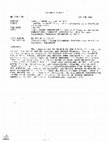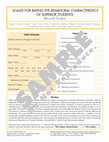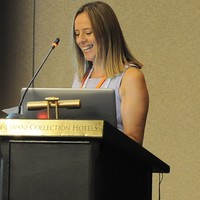Papers by Joseph Renzulli
Revista Educação Especial, Sep 23, 2014
The artist is nothing without the gift, but the gift is nothing without the work.
Gifted Child Quarterly, Jun 1, 1979
Talent, Jun 27, 2020
The good we secure for ourselves is precarious and uncertain until it is secured for all of us an... more The good we secure for ourselves is precarious and uncertain until it is secured for all of us and incorporated into our common life." Jane Addams
Reflections on Gifted Education, 2021
An in-depth understanding of science knowledge and the ability to utilize basic scientific skills... more An in-depth understanding of science knowledge and the ability to utilize basic scientific skills is fundamentally important for empowering students to make critical decisions and understand the world around them. However, many instructors teach science using rote memorization, which often leads to a lack of interest and student engagement. This article describes the extension of a decades-old teaching model, the Schoolwide Enrichment Model, into the domain of science. By applying this engaging and authentic model, instructors may learn how to more fully engage their students in science.

Journal of Creative Behavior, Jun 1, 1974
The purpose was to determine the effect of group size on both the total and the average per perso... more The purpose was to determine the effect of group size on both the total and the average per person fluency, flexibility, and originality of responses to problem solving tasks. One hundred sixty-three college juniors and seniors were assigned at random to groups of one, three, six, or twelve members. All groups were given identical instructions to respond aloud to three problem-solving tasks. Results showed that as group size increased, so did the total group fluency, flexibility, and originality; however, groups with three members were statistically indistinguishable from groups with six members. In terms of flexibility, six-member groups generated no more categories of responses than did twelve-member groups. Results also showed that as group size increased, the per-person contribution tended to diminish, and that groups of 'six or of twelve members appear to inhibit per-person contributions equally. (DT) ,g(2i ...m.-. 2 ,-;11z 6 8 Fluency, ylexibili-6y, and Originality as. .a ,Fun.c.ti.on_pf p.roup .S i.z.e.
Routledge eBooks, Sep 27, 2021

ABSTRACT This manual describes development and use of the revised "Scales for Rating the... more ABSTRACT This manual describes development and use of the revised "Scales for Rating the Behavioral Characteristics of Superior Students" (SRBCSS-R), a teacher judgment instrument appropriate for use as one measure in the identification of gifted students. Part 1 explains the judgmental and empirical procedures used to revise the items on the original SRBCSS-R and the methods for conducting two field test administrations of the revised scales. It also presents the results from the analyses and the reliability and validity evidence. Two tables summarize the construct validity data and the criterion-related data on teacher judgment measures. Part 2 provides instructions for administering and interpreting the SRBCSS-R and describes purposes for using the scales, guidelines for using the scales correctly, a teacher training exercise, and how to establish local norms. Five appendices include: the second field test version of the SRBCSS-R, a brief scale for rating student performance in a gifted program, a sample SRBCSS-R, the full teacher-training exercise for using the SRBCSS-R, guidelines for calculating local percentile rank norms, and an article, "A Practical System for Identifying Gifted and Talented Students" by Joseph S. Renzulli. (DB)

Journal of Advanced Academics, Jul 22, 2014
The passage of the Jacob K. Javits Gifted and Talented Students Education Act in 1988 was truly a... more The passage of the Jacob K. Javits Gifted and Talented Students Education Act in 1988 was truly a watershed moment in the field of gifted education. The National Research Center on the Gifted and Talented (NRC/GT) represented one part of the overall agenda of research and services supported by the Javits Act. How the Javits Act came to be and the rationale and decisions that formed the underlying framework for Javits are the foci of the first part of this article. The second part of this article provides a brief overview of the NRC/GT organization and mission. Multiple research teams associated with the NRC/GT implemented quantitative and qualitative research studies, invited outstanding scholars in the field to contribute to our research series, and carried out leadership duties assigned to the Center, which have been complementary additions to many contributions made by the other Javits projects over the past several decades.

Journal of Advanced Academics, Sep 8, 2014
One component of the Javits Gifted and Talented Students Education Act was provision for research... more One component of the Javits Gifted and Talented Students Education Act was provision for research on a national scale. In response, The National Research Center on the Gifted and Talented (NRC/GT) was created to design and implement a research portfolio. Based on emphasis in the Javits Act on underrepresented populations, on issues of identification and programming, and on priorities of an initial NRC/GT needs assessment, we elected to concentrate on summarizing the NRC/GT research reflecting identification practices, the status of current curricular and instructional strategies and practices, the development of challenging curricula, and the effectiveness of various professional development strategies as potential catalysts for change. The history underlying the development of the Javits Act and the organization and operation of the NRC/GT are described in the article titled “Laying the Base for the Future: One Cornerstone of the Javits Act” in this special issue of the Journal of Advanced Academics (JOAA).

Exceptional Children, Nov 1, 1971
These scales are designed to obtain teacher estimates of a student's characteristics in the areas... more These scales are designed to obtain teacher estimates of a student's characteristics in the areas of learning, motivation, creativity, leadership, art, music, drama, communication, planning, mathematics, reading, technology, and science. The items are derived from the research literature dealing with characteristics of gifted and creative individuals. It should be pointed out that a considerable amount of individual differences can be found within this population, and therefore, the profiles are likely to vary a great deal. Each item in the scales should be considered separately and should reflect the degree to which you have observed the presence or absence of each characteristic. Because the 14 dimensions of the instrument represent relatively different sets of behaviors, the scores obtained from the separate scales should not be summed to yield a total score. In addition, we have purposefully avoided developing national norms for this instrument. If you choose to develop local norms, they should be constructed for individual schools and grade levels. Instructions for calculating local norms can be found in the Scales for Rating the Behavioral Characteristics of Superior Students-Revised Edition: Technical and Administration Manual. Read each item in each scale and place an "x" in the box that corresponds with the frequency to which you have observed the behavior. Each item should be read with the beginning phrase, "The student demonstrates. . ." or "The student. . .".








Uploads
Papers by Joseph Renzulli